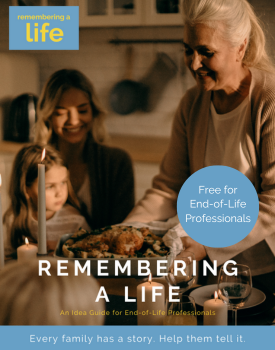One of the greatest challenges to surviving a suicide death loss and moving forward in one’s grief is the prevalent and damaging stigma that continues to be associated with this cause of death. This stigma is complicated by public misunderstanding of suicide, long-held myths about suicide, and the problematic language used to talk about suicide and the deceased. Moving forward with a suicide death loss is one of the most difficult experiences we may face in our lives, but if we can begin to unpack and understand the roots of the stigma that clings to suicide in our culture, we may become more empowered to challenge them and attain some healing in our personal bereavement.
In my own scholarly work on suicide, I have identified what are perhaps the four most common cultural myths that are imposed on survivors of suicide loss, which reinforce stigmas and harm our individual grieving processes. Exposing these attitudes for the myths they are may allow us to better honor our loved ones’ lives while also reinforcing facts over fiction to others who are also affected by suicide.
Myth 1: Suicide is always the result of clinical depression.
Not all suicide deaths are resultant of what we clinically term “depression.” It is also important to remember that while everyone may feel depressed from time to time, perhaps following the loss of a loved one, the loss of a job, the end to a romantic relationship, or other losses, clinical depression is not the same as situational depressed feelings, nor does one necessarily grow out of the other. Today, we must recognize that not all suicide deaths are linked so easily to clinical depression or, even for persons suffering from clinical depression, to that depression alone. Leading to a suicide attempt, there are a multitude of pressures at work on an individual, both social (including cultural, environmental, and interpersonal) as well as psychological (including one’s personal and familial mental health history, one’s losses, and one’s coping mechanisms for responding to suffering and trauma), and often biological (including chronic or life-threatening medical conditions, chemical imbalances, and effects of medications).
If your loved one died of suicide, it is natural for you to try to trace the components of their life that may have impacted their suicidality and led to their death. We want answers, and we may think that we need those answers to move on with our lives. Coming to terms with the impossibility of fully answering the question of “why?” is a hard realization, but it can begin to allow you to accept that you will never know fully exactly why the death occurred.
Myth 2: The suicide death was a “quick fix” for problems that could easily have been solved.
Because suicide continues to be an act surrounded by attempts to place blame, whether on the deceased, his or her family or romantic partner, or the medical community, if we seek less to find an outlet for blame and more to identify contributory forces on the individual, we may recognize that someone who has died of suicide was trapped in their pain and unable to see any other way out of their pain. Suicidal people do not want to die; they want to end their suffering. To treat suicide as a “quick fix” or “easy way out,” as is often done, is a failure to recognize the pain from which our loved one suffered. While we all experience pain, loss, and obstacles in our lives, individuals who die of suicide were not able to respond to their pain in healthy ways – often due to the same biopsychosocial forces that led to their suicidality.
After a suicide loss, we might become frustrated by all the options we believe that our loved one had to receive help. We might become angry at them or others for not getting the help that we think could have kept them alive. Recognizing that suicide is the product of a mind that isn’t working right can help us understand that while we can identify objective sources of assistance, in late-stage suicidality, our loved one’s mind genuinely could not see those possibilities anymore.
Myth 3: If we talk about suicide, or about our loved one who died of suicide, we may risk becoming suicidal or causing another person to become suicidal.
Historically, it was believed that if one spoke openly about the suicide death of a family or community member, they would risk “infecting” themselves or others by presenting suicide as an option. We still see effects of this misguided theory today; for example, we rarely, if ever, see the word “suicide” in an obituary or hear it at a memorial service for one who has died of suicide. Similarly, school communities are divided between communicating effectively with their students about the loss of a student to suicide and remaining fearful of romanticizing the death and presenting it as a possible “way out” for other students. Although this theory has been reexamined over the last decade and the idea that suicide is “infectious” is well on its way to being disproven, the idea that one can contract suicide from another person, as one would a virus or bacterial infection, still circulates in our contemporary culture.
We need to resist remaining silent about suicide and our own suicide losses. It is not contagious, and without open and accurate conversations about it, including in memorialization, silence will continue to function as a way of shaming survivors and cultivating more silence around these deaths. The suicide death of your loved one was the endpoint of their unique and extraordinary life, not the totality of their life. They deserve that their pain be acknowledged along with their accomplishments. Additionally, other people living with suicidality need to know that they can break silences about their suffering. Talking about suicide is more likely to lead to those people seeking help rather than suffering in silence.
Myth 4: Suicide is an act of cowardice or personal weakness; while everyone feels badly sometimes, suicide is “wrong,” “selfish,” or “weak.”
One of the most dangerous ways in which we bar understanding of those who have died of suicide is to treat their means of death as a personal failure. Historically-inherited cultural norms teach members of our society that a person who died of suicide was weak, cowardly, and uncaring about their loved ones. In reality, as the result of many social, psychological, and biological factors that have nothing to do with “giving up” or “choosing death,” suicide is not about cowardice; it isn’t about weakness. Representations of people who die of suicide as being less strong or less caring of others are not only false but harmful to their survivors and to their own legacy.
No one asks to become suicidal; no one hopes that suicidality will develop in them, just as no one wishes for a cancer to develop in them. Persons who attempt and die of suicide often report beforehand feeling ambivalent toward life and death, due to their suffering. Many cannot see or understand the impact their death will have on their loved ones, much in the same way that they cannot see options other than suicide in ending their pain. Anyone who lives for any length of time with exacerbating suicidality in a culture that shames suicidality is anything but a coward.
The Role of Language
While the above myths are but a few of the many that suicide loss survivors face, sometimes on a daily basis, we also need to confront the ways in which our culture reinforces stigma through the language used to refer to suicide and those who suffer from it. Let’s consider conventional terminology: people say that “John killed himself” or “John committed suicide”; both of these statements show nothing but ignorance for the complexity and devastation of suicidal pain, rendering someone who died of a life-threatening condition a virtual criminal. Within our cultural context, we “commit” crimes – murder, theft, robbery. If we “kill,” our cultural values demand that we ought to be punished. Criminalizing suicide through language is a barrier to understanding the pain of the suicidal individual.
Your loved one did not commit a crime; they do not deserve cultural or interpersonal degradation in language. They died of suicide, which is a cause of death that can be acute, chronic, or life-threatening, like many other causes of death. Their death was not an act of free will produced by a healthy mind but a tragic result of complex pain.
November 21, 2020 is International Survivors of Suicide Loss Day. To find events and additional resources, or to read and share stories of suicide losses, I encourage you to visit the American Foundation for Suicide Prevention’s website at www.afsp.org.
988 Suicide and Crisis Lifeline
If you or someone you know is struggling or in crisis, help is available. Call or text 988 or chat 988lifeline.org. Veterans, press 1 when calling.


